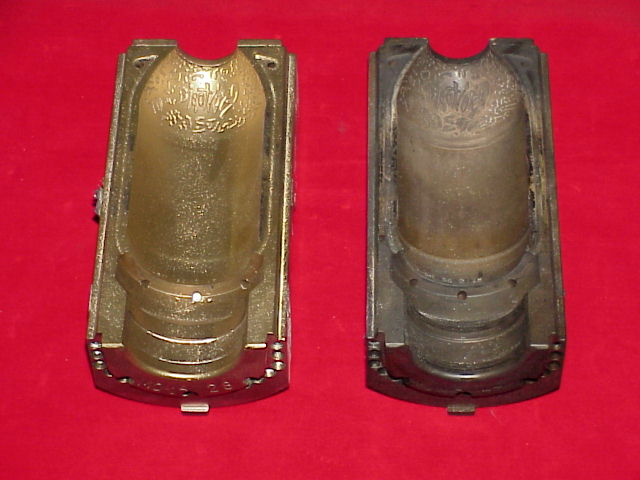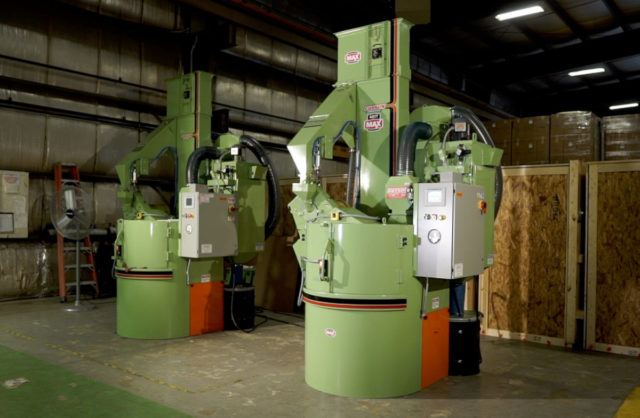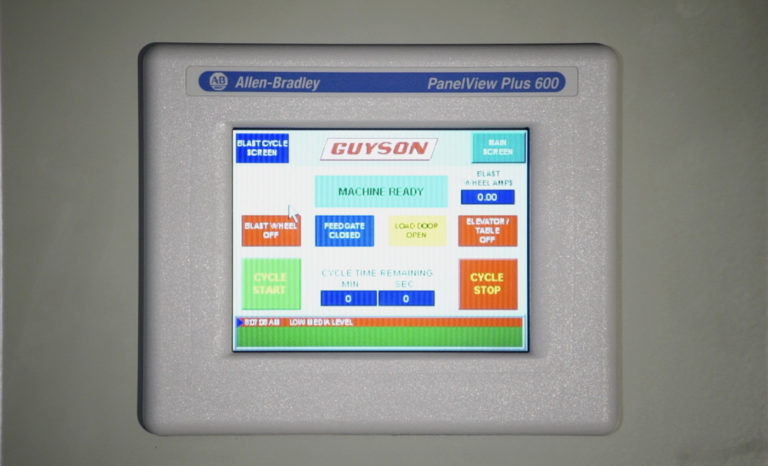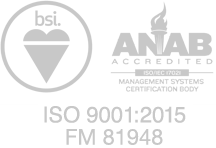How Guyson Changed the face of the Auto Part Reconditioning Business.
GLASS BOTTLE production and engine remanufacturing of auto parts do not appear to have much in common. However, it is through the glass industry that automotive component remanufacturing revolution came about. Guyson introduced a mold cleaning system perfected within the glass industry during the past 2 decades. Now the system is playing an important role in the engine remanufacturing business.

Glass bottle mold
A glass manufacturing company had Guyson glass bead blasting cabinet for about several years, using it to clean engine molds and other components. Expansion of their business revealed the limitations of manual operated unit which needs full time attention by a skIlled man and is not ideal for High volume work.
DiscussIng the problem with Guyson USA, they learned of the 401T Wheel Blast System, successfully developed by Guyson for the glass bottle container industry where the cleaning and maintenance of finely machined molds had alway been a problem. Cleaning had to be fast, thorough and economical without disturbing the metal and affecting the dimensional tolerances. In other words, the problem was the same as those faced by engine re-manufacturers.
While supervising trials at the Guyson factory the Automotive executive came to the conclusion that the system would improve efficiency in the following ways.
- By simple jigging, batches of up to ten cylinder heads from four cylinder engines could be cleaned completely within ten minutes. Without Jigging the number would be reduced to five.
- Because the process is automatic and no supervision is needed after loading the services of a skilled operator would be needed for a shorter time.
- The cleaning process would be quicker.
- Consumption of cleaning material would be less.
- There would be a reduction in the cost of maintaining the equipment.
- Batch blasting would be ideal for use in conjunction with the existing system of batch degreasing.
- The working environment in the machine shop would be improved.
The 401T MAX wheel blast system is an automatic blasting machine and a specially developed metal bead abrasive. The machine uses the airless blasting principal, in which the abrasive material is propelled onto the work surface from a rapidly rotating wheel by centrifugal force.

The machine installed at Townsend contains a 39.5 inch diameter rotary table with a load capacity of 1984 lbs; this automatically processes engine parts in batches but for commercial engines, bigger versions with a load capacity of up to 5291 lbs are available. Components are fed manually on to the rotary table, which is manufactured from high quality heavy gauge perforated Ni-hard cast alloy situated in the rubber line blast chamber and powered by a geared motor driving a centrally placed pedestal type axle. The parts on the table pass under a powerful stream of metal bead cleaning media hurled by the spinning motor driven turbine blades. Complete blast coverage of the total surface area is achieved during the time cycle. The whole operation is controlled by a pre-set solenoid governor, which determines the rate of rotation of the table and time cycle of the blasting.

Guyson Human machine interface touchscreen.
Overall control is from a console that incorporates a blast cycle timer. A safety switch stops the machine should the door to the blast chamber opened accidentally or if there is any malfunction whilst the machine is operating. The machine is prewired so that it is immediately ready for the work needing only to be linked with the electrical supply. It is free sending and no special foundations are required. The big advantage of automatic airless blast cleaning is the very low operating cost. Since the machine is totally enclosed losses of abrasive by dust and cary over are negligible. Abrasive is passes through a rotary screen and airwash after which it is ready for use again. Dust removed by the filtering action falls into a separate hopper. No air compressors and pipe lines are required and the labor needed is reduced to a minimum The medal medium developed by Guyson uses a special type of steel alloy, which is manufactured into beads and sorted into a specific size range by careful sieving and analysis. It took Guyson over a year to find the proper media which had the ability not only to remove efficiently the hard encrustation of carbonized deposits from glass mold cavities but also delicately clean the surface in such a way that the precise definitions of the mold were retained. After more that three years in service users from the glass industry confirmed that the system had produced no obvious mold wear and the fact that any dimensional change that may have occurred was physically impossible to measure using equipment normally available. Consequently it was determined to be suitable for use on cylinder heads.
Prior degreasing of wet and sticky components is always recommended, otherwise the media will not ricochet from the surface. Furthermore contaminated abrasive coagulates, reducing its effectiveness and the machines efficiency. A hot aqueous alkali solution containing a rust inhibitor should be employed for degreasing in a industrial washer.
Operating at 158-176 degrees F, components are allowed to soak for five to ten minutes and, being headed by the hot washing solution dry immediately after washing and are ready for placing in the blast cleaning machine. To avoid entrapment of any tiny particles of blasting media in the ports and airways of cylinder heads. After blasting, an air wash using compressed air but, as an additional precaution, also return the heads to the washer for final flushing out before reassembly.
Introduction of the 401T wheel blast system to the automotive industry, immediately produced the expected increase in output. Re-manufacturers found they could process components in loads of 40-50 and batches of eight respectively.
To capitalize upon the additional capacity many companies introduced a 24 hour shotlbasting service for large or small batches of metal engineering components. The reconditioning work includes cylinder heads, gear box section and the large stock of gears. At least one other engine manufacturer and several companies engaged in the reconditioning of other automotive components now are using 401t wheel blast systems.



